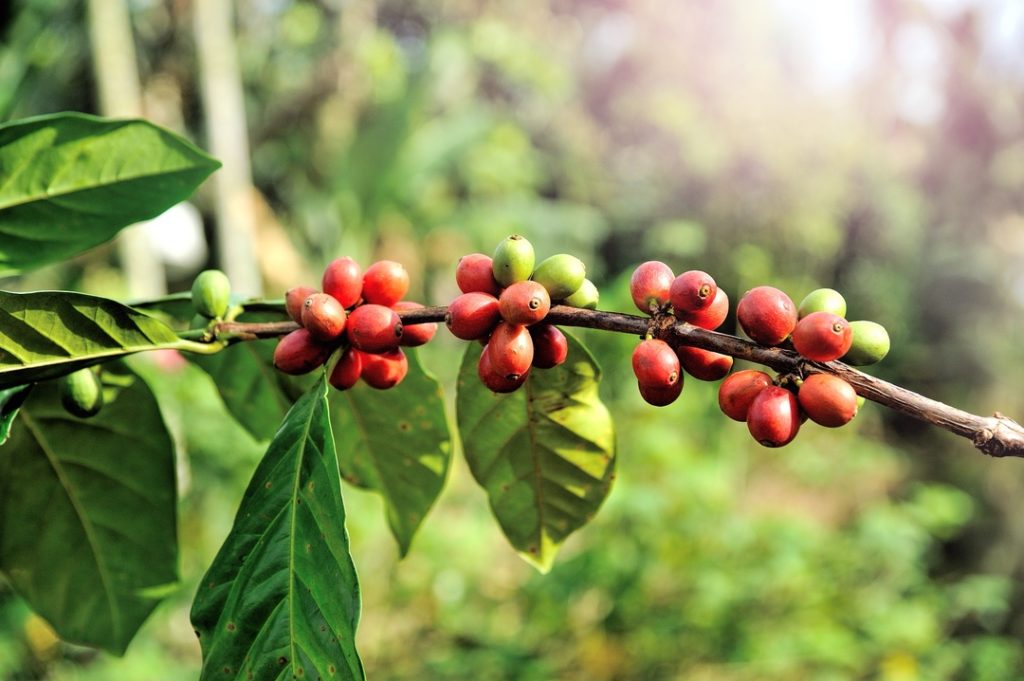
Ethiopia
Coffee
Coffea

General Description / Cultural Significance
Coffee, Coffea arabica, is grown in Ethiopia and is not only important to the people there, but to people worldwide. Ethiopia is the largest African producer of Arabica coffee, and the vast majority of the world’s coffee is derived from the plant. The beans of Coffea arabica are a source of caffeine and a stimulant. Beans are roasted, ground, and used to brew coffee, one of the most popular beverages in the world. It is thought by some that coffee cultivation began in Ethiopia sometime around the ninth century. Coffee is important to peoples’ diet in Ethiopia, as well as to their social lives, as drinking coffee with others is a beloved, classic social activity. Coffee itself is also known as a diuretic and dietary aid in traditional medicine. The bark of the plant is sometimes used to make parchment, and it is included in manure and mulches.
Women perform a coffee ceremony, sometimes multiple times a day, as an important part of their cultural and spiritual practice. This ceremony is age-old and is related to their Islamic heritage. Women begin the ceremony by spreading fresh aromatic grasses and flowers across the floor and burning incense to ward off evil. Then she places a clay pot of water over the coals and heats green coffee beans in a pan over the fire, slowly roasting them. The beans are roasted until they are brown and sometimes black, bathing in their own essential oils. Sometimes, the highly aromatic spices of cardamom, cinnamon, and cloves are added. The aroma is powerful and the experience smelling it is an important part of the ceremony. At that point, the smoke is also blown toward the guests to enhance their experience. The woman then grinds the roasted beans with a mortar and pestle. By this time the water is boiling, and she pours it over the coffee. This is a general description of the ceremony, but there are many nuances and variations across Ethiopia, all centering around smell and taste. After the coffee is served, sometimes butter or honey is added depending on the region of the country, and snacks like coffee cherries, roasted barley, and peanuts maybe also be served alongside the coffee.
Climate Change/Conservation Status
Currently, Ethiopia has been faced with one of the worst droughts of its history, and it is suspected that the effects of the drought will continue to be severe. There have been many crop failures, and efforts to find and plant more resilient foods are so far proving inadequate. Arabica coffee likes cool, equatorial climates, and adaption by the coffee plant means that it is moving up the mountains to cooler temperatures. Cattle grazing, harvesting of the plant for wood, and fires exacerbate threats to the plant’s microhabitat needs. All of this has put Coffee on the IUCN Red List of Threatened Species as endangered.
Ethiopia depends on coffee because it is central to the country’s economic stability and way of life, but climate change is having a profound impact on the crop’s production. New studies have found that Coffee Arabica, from which all coffee comes, may go extinct by the year 2080. The wild form of Arabica coffee is extremely important to coffee’s gene pool, and without it, coffee cannot be adapted to climate change in a commercial capacity. It is predicted that the increase in temperature in this region of Africa will make the coffee vulnerable to the damaging effects of fungus, coffee leaf rust, and an insect known as the coffee berry borer.
Ethiopia was at one point implementing initiatives to reduce the dangers of climate change by becoming carbon neutral, moving to become a green economy, and pushing back against the impacts of climate change by increasing their resilience. However, current conflicts and an unfolding humanitarian crisis has put these measures in jeopardy. It is uncertain what will happen as a result.
Alternate Names
Arabica coffee
Buna
Sources
Barry, A., 2012. UN: Somali famine is over, but action still needed. TheJournal.ie. [website]
Iscaro, J., 2014. The Impact of Climate Change on Coffee Production in Colombia and Ethiopia. Global Majority E-Journal, (5)1, pp. 33-43 [website]
O’Sullivan, R.J., Chadburn, H. & Davis, A.P., 2017. Coffea neoleroyi. The IUCN Red List of Threatened Species [website] DOI: 10.2305/IUCN.UK.2017-3.RLTS.T18290348A18539345.en
Regassa, S., Givey, C., & Castillo, G., 2010. The rain doesn’t come on time anymore: poverty, vulnerability and climate variability in Ethiopia. [ebook] Addis Ababa: Oxfam International. [website]
Schemm, P., 2017. Climate change threatens an ancient way of life in Ethiopia. The Washington Post. [website]
Terefe, D., 2019. As drought stokes urban hunger, Ethiopia dishes up free school meals. Reuters. [website]

